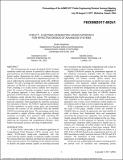STRUCT: A Second-Generation URANS Approach for Effective Design of Advanced Systems
Author(s)
Baglietto, Emilio; Lenci, Giancarlo; Concu, Davide
DownloadV01BT12A004-FEDSM2017-69241.pdf (1.734Mb)
PUBLISHER_POLICY
Publisher Policy
Article is made available in accordance with the publisher's policy and may be subject to US copyright law. Please refer to the publisher's site for terms of use.
Terms of use
Metadata
Show full item recordAbstract
This work presents the recently developed STRUCT hybrid turbulence model and assesses its potential to address the poor grid consistency and limited engineering applicability typical of hybrid models. Renouncing the ability to consistently bridge RANS, LES and DNS based on the computational grid size, we aim at addressing the engineering design needs with a different mindset. We opt to leverage the robustness and computational efficiency of URANS in all nearly homogeneous flow regions while extending it to locally resolve complex flow structures, where the concept of Reynolds averaging is poorly applicable. The proposed approach is best characterized as a second generation URANS closure, which triggers controlled resolution of turbulence inside selected flow regions. The resolution is controlled by a single-point parameter representing the turbulent timescale separation, which quantitatively identifies topological flow structures of interest. The STRUCT approach demonstrates LES-like capabilities on much coarser grids, and consistently increases the accuracy of the predictions from the baseline URANS at increasing grid finesse. The encouraging results show the potential to support effective design application through resolution of complex flow structures while controlling the computational cost. The ultimate objective is to continue improving the robustness and computational efficiency while further assessing the accuracy and range of applicability.
Date issued
2017-07Department
Massachusetts Institute of Technology. Department of Nuclear Science and EngineeringJournal
Volume 1B, Symposia: Fluid Measurement and Instrumentation; Fluid Dynamics of Wind Energy; Renewable and Sustainable Energy Conversion; Energy and Process Engineering; Microfluidics and Nanofluidics; Development and Applications in Computational Fluid Dynamics; DNS/LES and Hybrid RANS/LES Methods
Publisher
ASME International
Citation
Baglietto, Emilio, et al. "STRUCT: A Second-Generation URANS Approach for Effective Design of Advanced Systems." Proceedings of the ASME 2017 Fluids Engineering Division Summer Meeting, July 30-August 3, 2017, Waikoloa, Hawaii, ASME, 2017, p. V01BT12A004. © 2017 ASME
Version: Final published version
ISBN
978-0-7918-5805-9